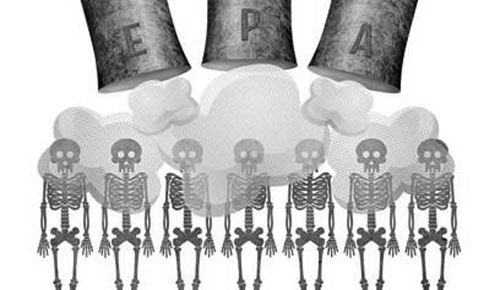The agency enlists an elite group of scientists to rubber stamp illegal experiments
The U.S. Environmental Protection Agency (EPA) is trying to use the prestigious National Academy of Sciences (NAS) to cover-up the agency’s illegal science experiments on humans. Four years ago, I broke the story in this paper that the EPA was conducting illegal toxicity experiments on human beings. In short, the EPA intentionally exposed hundreds of humans in a gas chamber to exceedingly high levels of air pollutants like diesel exhaust, soot and smog, in hopes of causing serious health effects that the agency could point to as justification for its costly and stringent outdoor air quality standards. Study subjects included the elderly (up to age 80), asthmatics, diabetics and people with heart disease — the very people EPAclaims are most susceptible to air pollution. EPA failed to tell these study subjects it believed the experiments could cause death.
The experiments were fundamentally unethical and illegal, as federal law prohibits treating humans as guinea pigs, especially for the mere purpose of advancing an agency’s regulatory agenda. Extra illegality was added by the agency’s failure to inform its human guinea pigs that it believed the experiments could kill them. After a series of articles in this paper, Freedom of Information Act requests and a federal lawsuit, Congress got involved by asking the EPAinspector general to review the allegations. The EPA inspector general eventually issued a March 2014 report in which it confirmed my allegations, including that the EPA had failed to inform the study subjects that EPA believed the experiments might kill them.
Fast forward to this summer when I received a startling tip from a source that the National Academy of Sciences had undertaken a review of the EPA’s human experiments. As it turns out, however, the NAS process isn’t really a review — it’s an EPA-instigated effort to whitewash EPA’s illegal conduct. Worse, the whitewash has been conducted, like the EPA’s experiments, pretty much in secret. The EPA was undoubtedly stung by the inspector general report that produced major media headlines such as the Associated Press’ “EPA Fails to Disclose Risks in Human Tests” and The New York Times’ “EPA Faulted for Failure to Report Risks.” To erase its wrongdoing, the EPA went the only place where it could control the outcome, the NAS.
Established in 1863 to advance science in America, the NAS has  become a prestigious honorary membership group for America’s elite scientists. While the NAS and its membership aren’t directly for hire, the NAS operates an affiliate called the National Research Council (NRC) that is.
become a prestigious honorary membership group for America’s elite scientists. While the NAS and its membership aren’t directly for hire, the NAS operates an affiliate called the National Research Council (NRC) that is.
The NRC gets itself hired by federal agencies in need of independent- and authoritativeappearing reports. So that’s what EPA did. It commissioned the National Research Council to review and paper over its illegal human experiments — in secret.
As the person who instigated the EPA inspector general’s report and is most familiar with EPA’s human experiment skullduggery, I only inadvertently learned of the NAS review in June 2016, more than one year after the NAS committee’s first meeting on June 1, 2015 and about two months after the committee’s fifth and last meeting in April 2016. Of the five committee meetings, only one, the first, is now described by the NAS as open to the public. But it really wasn’t. There was no public announcement of the June 1, 2015 meeting, and the only party to supply the committee with information at the meeting was the EPA. The June 1, 2015 meeting isn’t even listed in the NAS’ daily calendar for that date.
When I asked the NAS staff about the lack of notice, I was told that there was a notice on the committee’s web page. But of course, there had been no notice that the committee had been formed in the first place, so how would anyone know to check its web page?
I was able to obtain the materials made available to the committee by the EPA. None of these materials provide any context to the committee concerning the origins of the inspector general report or the context of the EPA human testing scandal. The material in the public docket is both incomplete and much of what’s there is misleading. Even assuming that committee members are acting in good faith, they are certainly acting in the dark.
When I found out about the committee, I contacted NAS staff and was told the committee was already working on its final report. But I was welcome to submit comments to the docket, which I hurriedly did. But I also asked for something else — for the opportunity to make a presentation to the committee. The controversy surrounding EPA’s experiments is complex and summary words appended to the docket just don’t do it justice. I have also written to all committee members asking for the opportunity to make a presentation. But as of yet, I have not even received an acknowledgment of my request.
But I have heard from a reliable source close to the NAS committee that the “fix is in” and EPA is likely to get the clean bill of health for which it is paying.
Now, I have dealt with the EPA for over 25 years. As detailed on this page many times, I have come not to expect good faith or honesty from the agency. The NAS on the other hand is a different matter. The NAS holds itself out as “nation’s pre-eminent source of highquality, objective advice on science, engineering and health matters.” If that is true, the NAS is certainly doing itself and its elite membership no favors by being paid to conduct a secret and ill-informed whitewashing of EPA’s illegal conduct.
Steve Milloy publishes JunkScience.com and is a senior legal fellow at the Energy and Environmental Legal Institute.
